"Man loves company - even if it is only that of a small burning candle." -Georg C. Lichtenberg
It's the end of the week here at Starts With A Bang, and so it's time for still another Ask Ethan! This is -- for those of you wondering -- the final Ask Ethan we'll have here on Scienceblogs; starting next week we'll move the series over to Medium with the rest of the new Starts With A Bang content. But keep on sending in your questions and suggestions, and not only will we continue using this site as a forum for the new posts, but next week we'll begin a new series unique to Scienceblogs, where I'll call out and respond to the best comments that have been left here over the past week! So without further ado, today's question comes from Alan Bloomfield, who asks:
As I understand it solar mass stars "burn" hydrogen in their cores for several billion years until a helium core forms and the star evolves off the main sequence. But surely the helium core has been forming atom by atom since day one. Likewise, massive stars don't suddenly develop an iron core and go supernova, the formation of the iron core is also a gradual process. How does one reconcile this apparent event versus process dichotomy in stellar evolution?
Ahh, the lives and deaths of stars. Let's dive inside a newborn Sun-like star and take a look at what's happening!
In a young star cluster (like NGC 265, above), you have stars of all different masses in there, ranging from the most massive, hottest O-and-B class stars that are tens (or even hundreds) of times as massive as our Sun, all the way down to the lowest mass, reddest and dimmest M-class stars. (There are many times more "failed stars" in there as well, but that's a story for another time.)
What gives these stars the colors and brightnesses that they are?
The flippant answer would be "their mass," but the truth is a little more nuanced, and a little more enlightening.
You see, the reason these stars are shining at all is because there's nuclear fusion taking place in their cores. After huge amounts of mass -- the equivalent of some 25,000 Earths in even the lowest-mass M-class star -- contract together into protostars, heating up tremendously, the densities and temperatures in the cores become sufficient to ignite a self-sustaining nuclear fusion reaction.
The main differences between what makes a star so blue and bright, as opposed to red and dim, has everything to do with the temperature inside! Inside the Sun, for example, the temperature at the very core is around 15 million Kelvin, and nuclear fusion happens somewhat quickly there.
But as we move farther out, the temperature drops, but the rate of fusion drops exponentially with temperature! By time we're 25% of the way out of the Sun, the temperature has dropped by less than a factor of two, and yet the rate of fusion is less than 1% of what it is at the core!
 Image credit: B. Stromgrew (1965), retrieved from http://fusedweb.llnl.gov/cpep/chart_pages/5.plasmas/sunlayers.html.
Image credit: B. Stromgrew (1965), retrieved from http://fusedweb.llnl.gov/cpep/chart_pages/5.plasmas/sunlayers.html.
This is why a star whose temperature might be half that of the Sun can live hundreds of times as long, and an incredibly hot star -- like R136a1 (at the core of the cluster below), with 260 times the mass of the Sun -- will live less than 0.1% as long as our Sun.
 Image credit: ESO/P. Crowther/C.J. Evans, via http://www.eso.org/public/images/eso1030a/.
Image credit: ESO/P. Crowther/C.J. Evans, via http://www.eso.org/public/images/eso1030a/.
Now, that's the difference between stars when they're first born. But as they live and burn through their fuel, the regions with spent fuel in them starts to collapse. There are a number of different ways to change an objects volume; the collapse happens adiabatically, which means the entropy remains constant but the temperature rises inside the star! And that means both that a larger region around the core can fuse whatever fuel is burning at the time, and also that the rate of fusion goes up.
In addition to everything else that happens, this means the temperature and luminosity of the stars are all expected to gradually rise as they age.
What happens over time is that there's a certain amount of radiation pressure that needs to come out of all layers of the star in order to hold it up against gravitational collapse. The Sun is a constant radius because the outward radiation pressure at the surface is (roughly) the same as the inward gravitational pull. But when the core of a star -- and this is true of any layer in the star -- runs out of the fuel it's burning, the radiation pressure drops precipitously, and starts to lose against the pull of gravity.
There are two options here: either the core can contract and heat up sufficiently to ignite more fusion -- whether hydrogen, helium, or in the case of the most massive stars, carbon fusion and beyond -- or it can remain inert, because it can't heat up enough to burn the next stage of fuel, in which case the end of the star is near.
The helium core takes a long time to form -- millions of years in even the most massive stars -- and helium burning takes maybe 10% of the time that hydrogen burning does. In stars that achieve carbon burning, the timescales from the first fusion of carbon in the core until the iron inner core causes a supernova is on the order of a thousand years, and no more. That part of the story is fast!
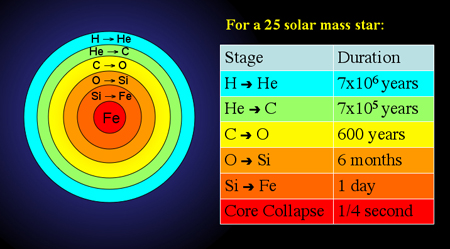 Image credit: © Swinburne University of Technology, via https://astronomy.swin.edu.au/cms/astro/cosmos/C/core-collapse.
Image credit: © Swinburne University of Technology, via https://astronomy.swin.edu.au/cms/astro/cosmos/C/core-collapse.
In reality, once the inner core of a Sun-like star runs out of hydrogen fuel in its central region -- something that will happen to our own Sun in 5-to-7 billion years -- it will expand into a subgiant star first, where it will remain for hundreds of millions of years before igniting helium and becoming a red giant. But that first step of becoming a subgiant is when it will leave the main sequence for good.
After that, all the other steps are relatively rapid, as the "main sequence" is called that for a reason: it's where all stars spend the main amount of their lifetimes.
Inside a higher-mass star, temperature is everything, and convection is too slow to mix the elements thoroughly enough. And that's why even the helium our Sun is making in its core today will help quench the fusion reactions billions of years from now; it would take hundreds of billions of years for the whole core of a star to circulate new elements into it. (Something that does happen only in M-class stars.)
And that's how stellar evolution really happens: a lot closer to "all-at-once" than most of us realize!
Thanks for joining me for half-a-year of Ask Ethan here on Scienceblogs, and keep sending in your questions and suggestions for a chance to have them answered on Medium! See you all then!


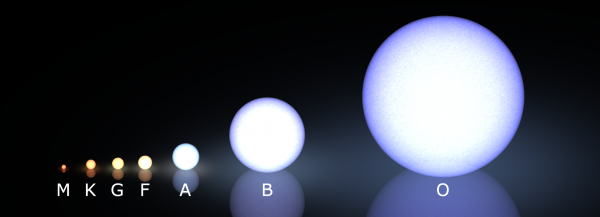
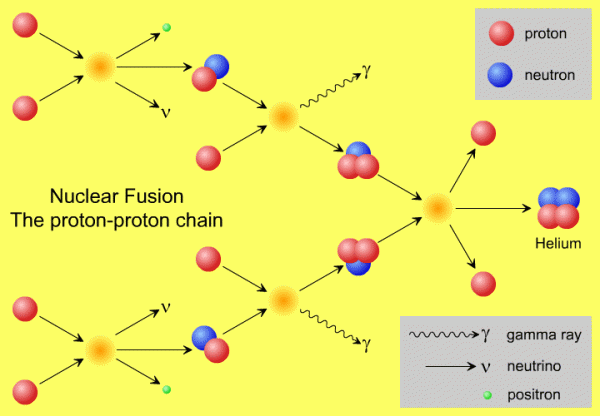

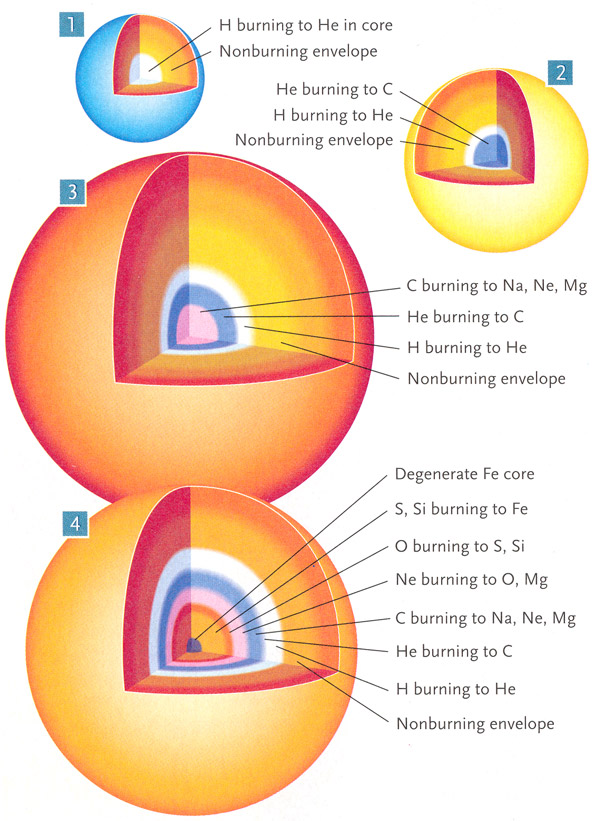
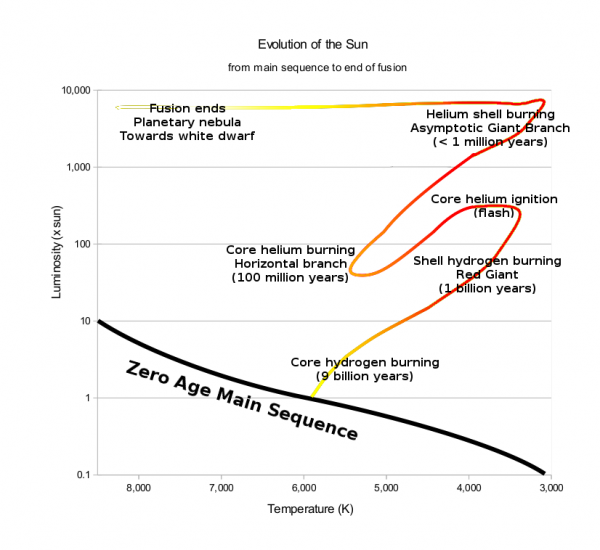
do you think there are extratersterial beings out there in the constallations?
Another enlightening chapter, Ethan. Thanks.
Just imagine, if the universe were not full of photons, we would not be aware of our environment by visual means.
The big bang. Cause & effect. It just occurred to me that for the Big Bank to have happened, all that energy must have come from somewhere.
Could it have come from another universe or another dimension? It was 'there' and now it's 'here'?!!!
I always thought one of the great things about smoking cigarettes was that you got to carry around a burning thing! With smoke! I am MAN, and I command a burning thing. Sorry, nothing about photons.
" all that energy must have come from somewhere."
Yeah, it came from the negative gravitational potential of the mass created.
Do we actually know that, Wow?
I know I've heard the argument before that the energy in the universe could have come from "nothing" because all energy has an equal amount of gravitational potential energy, which is negative. (In my very oversimplified view - energy is the ability to do work, work is when a force exerts a push. Gravity exerts a pull and is therefore negative energy). But I've always heard it phrased as "the universe could have" not "the universe did" - both because we don't understand the mechanisms that led to what most people would call the big bang, and because there may be other alternatives. (In particular, I remember a separate interpretation of the same concept in general relativity is that energy does not have to be conserved in general relativity because time-translation invariance does not hold). Am I wrong?
"Do we actually know that, Wow?"
As much as we know that f=ma. It explains everything and Occam would indicate if we have a sufficient explanation, then we need not look for a more complex one.
This is going to sound a bit whiney I guess, but I'm probably going to stop reading your blog. I mostly read blogs on my phone when I commute and I'm using an atom/rss reader for that. But nowdays every blog entry here on scienceblogs is truncated and to read the full thing I have to go to medium.com. And quite frankly, medium sucks big. Well, first of all, having to leave my feed reader is frustrating in itself, it's much nicer to be able to read all blogs the same way, but I can stand that when the content is interesting enough. But medium makes the reading experience really horrible with the standard browser on Android 2.3.
It seems that medium tries to do too much javascript magic which just breaks on my phone. The pages on medium take forever to load. The cover image at the beginning is zoomed up in a ridiculous way, every pixel is a centimeter on the small phone screen, so to get to the content I have to scroll forever. And then there is some javascript magic again which reacts to presses on the screen, so every now and then, when I try to scroll while reading, the bloody cover image reloads (which takes forever) so I have to sit there and wait and then start scrolling again to try to find where I was reading before it messed up. When reading a post yesterday this happened three times before I just gave up, it's not possible to read with all the interruptions due to the broken javascript.
So, pretty please, can you start putting the full content of your posts on scienceblogs so that I don't have to go to medium.com all the time. Or if you can get medium to stop doing so much magic in javascript so that it doesn't break with the Android browser.